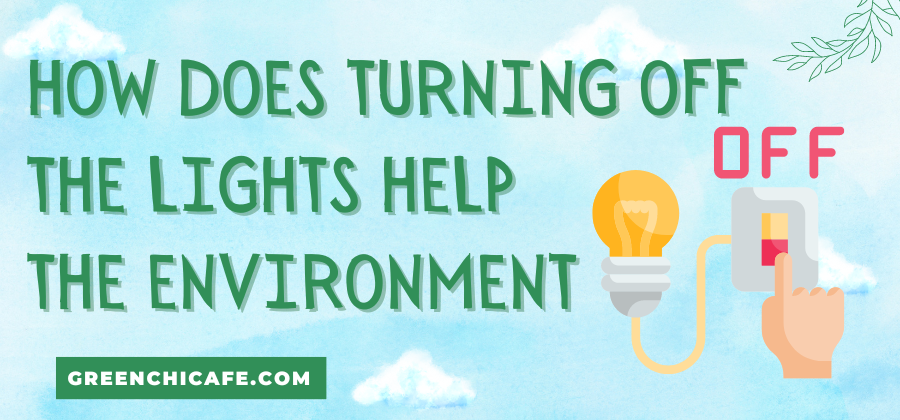Turning off the lights helps the environment by saving electricity and reducing carbon emissions.
This simple action can make a meaningful impact in mitigating climate change.
Read on to learn why it’s important and how much energy we can save by switching off unused lights.
How Does Turning Off the Lights Help the Environment?

Yes, turning off the lights absolutely helps the environment by reducing electricity usage and greenhouse gas emissions that contribute to climate change.
Turning off the lights is one of the easiest ways to reduce energy consumption and carbon emissions that contribute to climate change.
By turning off lights when not in use, we can save significant amounts of electricity and prevent the release of harmful greenhouse gases into the atmosphere.
Even though it seems small, the widespread adoption of turning off lights can have a noticeable effect on lowering worldwide energy usage and emissions.
Key Points
- Turning off lights saves electricity and prevents carbon emissions from power plants.
- Lighting accounts for 15% of household electricity use; turning lights off reduces energy bills.
- Consistently turning off just one light bulb can save over 50 lbs of carbon dioxide emissions per year.
How Much Energy Do Lights Use?
On average, lighting accounts for about 15% of household electricity usage.
The amount of energy consumed by lighting depends on the type of bulb.
Traditional incandescent bulbs are inefficient, using 60-90 watts.
CFL bulbs use 70% less energy, while LED bulbs consume up to 90% less electricity.
By switching off just one 60-watt incandescent bulb for 6 hours per day, you can save about 35 kWh of electricity per year.
That equates to a reduction of over 50 pounds of carbon dioxide released, which is a major greenhouse gas contributing to climate change.
Does Turning Lights Off Save Electricity?
Yes, turning off lights when not in use directly reduces electricity consumption.
According to the U.S. Department of Energy, lighting represents 11% of total energy expenses for households.
By turning off lights consistently, families can reduce their lighting energy usage by 45%.
Workplaces can cut lighting electricity usage by 50-80% simply by creating a culture where people switch off lights when leaving a room.
The less time lights remain on, the more electricity is saved.
How Much Money Can You Save by Turning Off Lights?
By practicing consistent light switching habits, households can save a meaningful amount on electricity costs.
Based on average residential electricity rates, turning off just one 60-watt incandescent bulb for 6 hours each day can save around $4 per year.
Extending that to all suitable lights, households can save $70 or more annually simply by developing a habit of turning off lights.
Workplaces with high electricity costs and numerous lights can experience even greater savings.
Office buildings save an average of $1,250 annually for every 10,000 square feet by encouraging employees to turn off lights when not needed.
For large companies, the compound savings are significant.
Does Turning Lights Off Reduce Carbon Emissions?
Absolutely. Generating electric power from fossil fuels releases significant greenhouse gases, primarily carbon dioxide, into the atmosphere.
By reducing electricity demand through turning off lights, less fuel is burned and fewer emissions are created.
Even from a single light bulb, turning lights off can prevent over 50 pounds of carbon dioxide released over a year.
Lighting accounts for 5% of total U.S. carbon dioxide emissions from electricity generation.
Widespread adoption of turning off lights when not in use can make a meaningful dent in reducing a home’s or business’s carbon footprint.
Making it a habitual practice is an easy way to combat climate change.
What Are Other Benefits of Turning Off Lights?
In addition to saving electricity and cutting carbon emissions, turning off lights also extends the lifespan of bulbs.
Frequent on/off cycles do not harm most modern lightbulbs or reduce their longevity.
By turning off lights, you will gain more hours of illumination before needing to change bulbs, saving you money.
Turning lights off in unoccupied rooms also helps prevent unnecessary ambient light, allowing for a better sleep environment.
Excess artificial light, particularly with LEDs and fluorescents, can disrupt sleep cycles and the natural circadian rhythm.
Does Turning Lights Off Reduce Air Pollution?
Turning off unnecessary lights does help lower air pollution associated with electricity generation.
Most U.S. power plants burn fossil fuels like coal and natural gas to produce electricity.
When these fuels are combusted, toxic air pollutants are released, such as sulfur dioxide, mercury compounds, and particulate matter.
By reducing electricity demand through turning off lights, we can decrease the amount of pollutants emitted into the air from power plants.
This improves public health by reducing exposure to harmful power plant air emissions.
Does Switching Bulbs Help More Than Turning Off Lights?
For maximum energy and emissions savings, it is best to turn off lights when possible and use efficient lighting.
However, if it comes down to choosing just one, turning lights off consistently will save more energy than changing bulbs alone.
New bulbs only realize savings when turned off – they use full power when left on needlessly.
Still, using energy-efficient LED lighting maximizes savings.
An LED bulb uses at least 75% less power than an incandescent.
Combined with turning off lights diligently, LEDs will yield the greatest energy and emissions reductions.
What Are the Best Practices for Turning Off Lights?
To fully realize the benefits of turning off lights, make it a habit by following these tips:
- Turn off lights in unoccupied rooms, even if leaving only briefly. Don’t assume someone else will do it.
- Install timers, motion sensors, and occupancy controls to automatically turn off lighting when not in use.
- Use dimmers, nigh lights, or task lighting only in spaces that need illumination at night.
- Turn off outdoor lighting fixtures when not needed for safety or decoration.
- Enable power management settings on computers, displays, and other equipment to turn off when inactive.
- Use natural daylight instead of artificial light whenever sufficient.
- Improve workplace culture around sustainability and encourage employees to turn off lighting.
How Much Energy Do You Save By Turning Off The Television At The Mains?
Turning off the television at the main power source rather than leaving it in standby mode yields significant electricity savings.
When a TV is switched off but still plugged in, it can use up to 10% of its full running power in standby mode.
For a typical 50-inch LCD television that is left in standby for 10 hours a day, this equates to over 50 kWh of wasted electricity over a year.
By unplugging the TV from the mains or using a power strip that can be switched off, all vampire or standby power consumption is eliminated.
Doing this could save 50-100 kWh per year for the average household depending on TV size and usage habits.
Unplugging electronics and using power strips is always advisable to maximize energy savings by preventing standby power drain.
How Does Turning Off the Heating Save The Environment?
Heating systems like furnaces and boilers consume significant energy, mostly derived from the burning of fossil fuels.
By turning down or switching off heating when not needed, less fuel is burned, preventing greenhouse gas emissions and saving energy.
For example, lowering a thermostat by just 1 degree Celsius can reduce heating fuel usage, and therefore carbon dioxide emissions, by up to 10%.
Developing energy-conserving habits like turning off radiators and adjusting the heating lower when leaving the home and at night can make a meaningful difference in reducing a household’s environmental footprint.
Automated smart thermostats make it even easier to minimize heating usage during unoccupied periods.
By keeping heating off when possible, we decrease the environmental impacts associated with generating the electricity and burning the fuels required to power heating systems.
How Can You Save Electricity At Home With Simple Steps?

Many simple measures can have a significant cumulative effect on lowering home electricity usage.
Here are five easy ways to save power:
- Switch off lights when leaving a room and use task lighting. Replace bulbs with LEDs.
- Unplug devices and electronics when not in use or use smart power strips. Don’t leave items on standby.
- Use cold laundry cycles and hang dry clothes instead of a dryer. Only run full loads.
- Adjust the thermostat lower in winter and higher in summer. Turn off radiators in unused rooms.
- Replace old appliances and choose energy-efficient models. Refrigerators, washers and dishwashers use the most energy.
Adopting new habits like these to avoid wasting electricity in homes is impactful.
Small daily actions multiply into major energy savings over time.
The Bottom Line
So, how does turning off the lights help the environment?
Turning off the lights is a simple but meaningful way we can all combat climate change through reducing energy consumption and carbon emissions.
Just by switching off unnecessary lights consistently, households and businesses can save noticeable amounts of electricity, costs, and greenhouse gas impacts.
Combined with efficient lighting, diligent light switching habits make a difference in creating a more sustainable future.
Frequently Asked Questions
How much money can turning off lights save?
By making a habit of turning off lights, a typical household can save $70 or more per year on electricity costs. Offices can save over $1,000 annually per 10,000 square feet.
Does frequently turning lights on and off reduce bulb life?
No, frequent switching does not harm most modern bulbs or reduce their longevity. Turning lights off saves energy without shortening bulb lifespan.
What are other benefits of turning off lights?
Additional benefits include reducing ambient light for better sleep, minimizing air pollution from power plants, and extending the operating life of bulbs.
What household actions save the most energy?
Along with turning off lights, the best ways to save energy at home are upgrading lighting, using efficient appliances, turning off electronics, sealing air leaks, and modifying thermostat settings.
At GreenChiCafe, we are passionate about protecting the environment and conserving our planet’s precious natural resources. Please check out our website for more great content on living sustainably.

Annie is a passionate environmental writer and activist. She has been writing about sustainability, conservation, and green living for over 15+ years. Annie is dedicated to raising awareness about environmental issues and providing practical tips for living an eco-friendly lifestyle. When she’s not writing, you can find her volunteering with local environmental organizations, teaching workshops on zero waste living, or exploring nature. Feel free to get in touch with Annie: annie@greenchicafe.com
